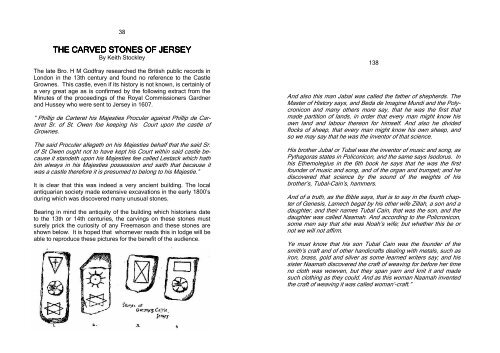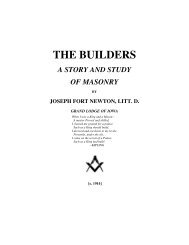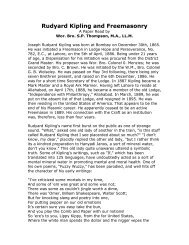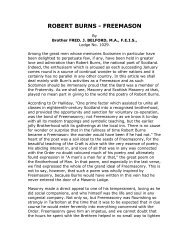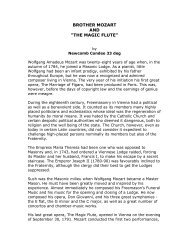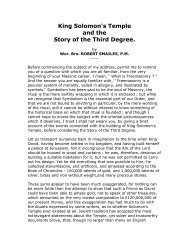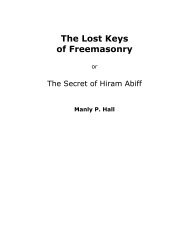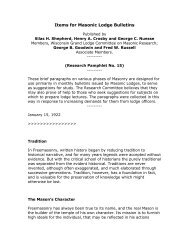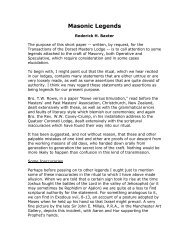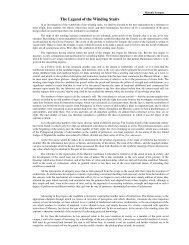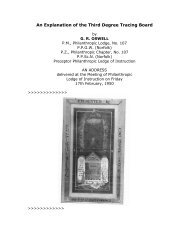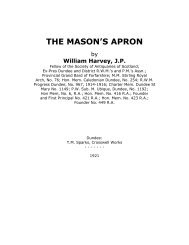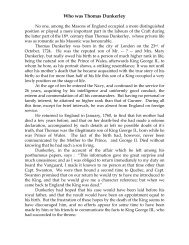Through the Key Hole - RoseCroix.org.au
Through the Key Hole - RoseCroix.org.au
Through the Key Hole - RoseCroix.org.au
You also want an ePaper? Increase the reach of your titles
YUMPU automatically turns print PDFs into web optimized ePapers that Google loves.
38<br />
THE CARVED STONES OF JERSEY<br />
By Keith Stockley<br />
The late Bro. H M Godfray researched <strong>the</strong> British public records in<br />
London in <strong>the</strong> 13th century and found no reference to <strong>the</strong> Castle<br />
Grownes. This castle, even if its history is not known, is certainly of<br />
a very great age as is confirmed by <strong>the</strong> following extract from <strong>the</strong><br />
Minutes of <strong>the</strong> proceedings of <strong>the</strong> Royal Commissioners Gardner<br />
and Hussey who were sent to Jersey in 1607.<br />
“ Phillip de Carteret his Majesties Proculer against Phillip de Carteret<br />
Sr. of St. Owen foe keeping his Court upon <strong>the</strong> castle of<br />
Grownes.<br />
The said Proculer allegeth on his Majesties behalf that <strong>the</strong> said Sr.<br />
of St Owen ought not to have kept his Court within said castle bec<strong>au</strong>se<br />
it standeth upon his Majesties fee called Lestack which hath<br />
bin always in his Majesties possession and saith that bec<strong>au</strong>se it<br />
was a castle <strong>the</strong>refore it is presumed to belong to his Majestie.”<br />
It is clear that this was indeed a very ancient building. The local<br />
antiquarian society made extensive excavations in <strong>the</strong> early 1800’s<br />
during which was discovered many unusual stones.<br />
Bearing in mind <strong>the</strong> antiquity of <strong>the</strong> building which historians date<br />
to <strong>the</strong> 13th or 14th centuries, <strong>the</strong> carvings on <strong>the</strong>se stones must<br />
surely prick <strong>the</strong> curiosity of any Freemason and <strong>the</strong>se stones are<br />
shown below. It is hoped that whomever reads this in lodge will be<br />
able to reproduce <strong>the</strong>se pictures for <strong>the</strong> benefit of <strong>the</strong> <strong>au</strong>dience.<br />
138<br />
And also this man Jabal was called <strong>the</strong> fa<strong>the</strong>r of shepherds. The<br />
Master of History says, and Beda de Imagine Mundi and <strong>the</strong> Polycronicon<br />
and many o<strong>the</strong>rs more say, that he was <strong>the</strong> first that<br />
made partition of lands, in order that every man might know his<br />
own land and labour <strong>the</strong>reon for himself. And also he divided<br />
flocks of sheep, that every man might know his own sheep, and<br />
so we may say that he was <strong>the</strong> inventor of that science.<br />
His bro<strong>the</strong>r Jubal or Tubal was <strong>the</strong> inventor of music and song, as<br />
Pythagoras states in Policonicon, and <strong>the</strong> same says Isodorus. In<br />
his E<strong>the</strong>molegius in <strong>the</strong> 6th book he says that he was <strong>the</strong> first<br />
founder of music and song, and of <strong>the</strong> <strong>org</strong>an and trumpet; and he<br />
discovered that science by <strong>the</strong> sound of <strong>the</strong> weights of his<br />
bro<strong>the</strong>r’s, Tubal-Cain’s, hammers.<br />
And of a truth, as <strong>the</strong> Bible says, that is to say in <strong>the</strong> fourth chapter<br />
of Genesis, Lamech begat by his o<strong>the</strong>r wife Zillah, a son and a<br />
d<strong>au</strong>ghter, and <strong>the</strong>ir names Tubal Cain, that was <strong>the</strong> son, and <strong>the</strong><br />
d<strong>au</strong>ghter was called Naamah. And according to <strong>the</strong> Policronicon,<br />
some men say that she was Noah’s wife; but whe<strong>the</strong>r this be or<br />
not we will not affirm.<br />
Ye must know that his son Tubal Cain was <strong>the</strong> founder of <strong>the</strong><br />
smith’s craft and of o<strong>the</strong>r handicrafts dealing with metals, such as<br />
iron, brass, gold and silver as some learned writers say; and his<br />
sister Naamah discovered <strong>the</strong> craft of weaving for before her time<br />
no cloth was wowven, but <strong>the</strong>y span yarn and knit it and made<br />
such clothing as <strong>the</strong>y could. And as this woman Naamah invented<br />
<strong>the</strong> craft of weaving it was called woman’-craft.”


